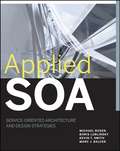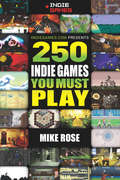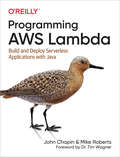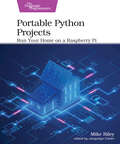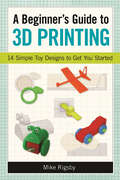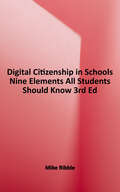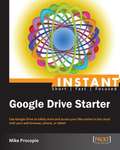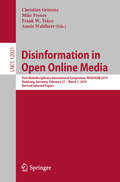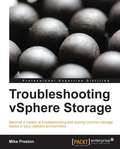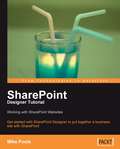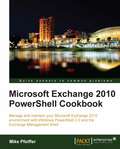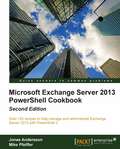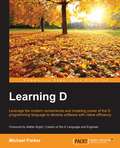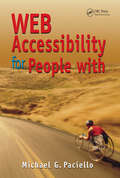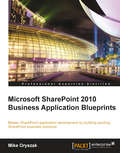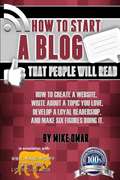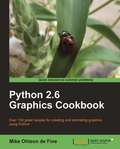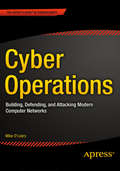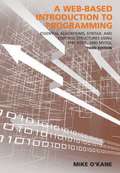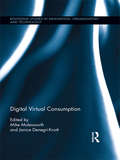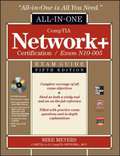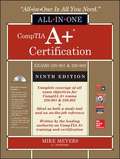- Table View
- List View
Applied SOA: Service-Oriented Architecture and Design Strategies
by Mike Rosen Boris Lublinsky Kevin T. Smith Marc J. BalcerEndorsed by all major vendors (Microsoft, Oracle, IBM, and SAP), SOA has quickly become the industry standard for building next-generation software; this practical guide shows readers how to achieve the many benefits of SOA Begins with a look at the architectural principles needed to create successful applications and then goes on to examine the process for designing services and SOA implementations Each stage of the design process has an accompanying chapter that walks readers through the details and provides helpful tips, techniques, and examples The author team of SOA practitioners also provides two unique, comprehensive, end-to-end case studies illustrating the architectural and design techniques presented in the book
250 Indie Games You Must Play
by Mike RoseThis book is a guide to the expanding world of indie gaming. It helps readers to understand why indie games are so important to so many people in the entertainment industry. The book covers puzzlers, platformers, beat 'em ups, shoot 'em ups, role-playing, and strategy.
Programming AWS Lambda: Build and Deploy Serverless Applications with Java
by Mike Roberts John ChapinServerless revolutionizes the way organizations build and deploy software. With this hands-on guide, Java engineers will learn how to use their experience in the new world of serverless computing. You’ll discover how this cloud computing execution model can drastically decrease the complexity in developing and operating applications while reducing costs and time to market.Engineering leaders John Chapin and Mike Roberts guide you through the process of developing these applications using AWS Lambda, Amazon’s event-driven, serverless computing platform. You’ll learn how to prepare the development environment, program Lambda functions, and deploy and operate your serverless software. The chapters include exercises to help you through each aspect of the process.Get an introduction to serverless, functions as a service, and AWS LambdaLearn how to deploy working Lambda functions to the cloudProgram Lambda functions and learn how the Lambda platform integrates with other AWS servicesBuild and package Java-based Lambda code and dependenciesCreate serverless applications by building a serverless API and data pipelineTest your serverless applications using automated techniquesApply advanced techniques to build production-ready applicationsUnderstand both the gotchas and new opportunities of serverless architecture
Portable Python Projects: Run Your Home On A Raspberry Pi
by Mike RileyDiscover easy ways to control your home with the powerful new Raspberry Pi hardware. Program short Python scripts that will detect changes in your home and react with the instructions you code. Use new add-on accessories to monitor a variety of measurements, from light intensity and temperature to motion detection and water leakage. Expand the base projects with your own custom additions to perfectly match your own home setup. Most projects in the book can be completed in under an hour, giving you more time to enjoy and tweak your autonomous creations. No breadboard or electronics knowledge required! Get to know the latest Raspberry Pi hardware, and create awesome automation solutions for home or work that don't require an electronics degree, cumbersome add-ons, or expensive third-party subscription services. Create easy to run Python scripts on your own that make your Pi do things that would have required a team of automation experts to build only a few years ago. Connect to and control popular home automation lighting systems from a Raspberry Pi. Trigger autonomous actions based on movement, temperature, and timer events. Power on your own computer and appliances using your voice. Remotely control infrared-enabled consumer electronics, create chatbots to retrieve personalized items of interest, and implement a temperature-monitoring room fan. These are just some of the projects that the book will show you how to make. Most projects can be completed and operational in under an hour, and do not require any messy schematics or a spaghetti bowl of wires and breadboard-attached circuits to operate. Control your home or office exactly the way you want instead of relying on an expensive mysterious box of third-party technology to do it for you. What You Need: Raspberry Pi (Pi 4 Model B or higher recommended) running Raspberry Pi OS
A Beginner's Guide to 3D Printing: 14 Simple Toy Designs to Get You Started
by Mike RigsbyA Beginner's Guide to 3D Printing is the perfect resource for those who would like to experiment with 3D design and manufacturing, but have little or no technical experience with the standard software. Author Mike Rigsby leads readers step-by-step through 15 simple toy projects, each illustrated with screen caps of Autodesk 123D Design, the most common free 3D software available. The projects are later described using Sketchup, another free popular software package. Beginning with basics projects that will take longer to print than design, readers are then given instruction on more advanced toys, including a baking-powder submarine, a train with expandable track, a multipiece airplane, a rubber band-powered car, and a noise-making push toy with froggy eyes. Once trained in the basics of computer-aided design, readers will be able to embark on even more elaborate projects of their own creation.
Digital Citizenship in Schools: Nine Elements Students Should Know
by Mike RibbleDigital Citizenship in Schools, third Edition is an essential introduction to digital citizenship. Starting with a basic definition of the concept and an explanation of its relevance and importance, author Mike Ribble goes on to explore the nine elements of digital citizenship. He provides useful audit and professional development activities to help educators determine how to go about integrating digital citizenship concepts into the classroom. Activity ideas and lesson plans round out this timely book.
Instant Google Drive Starter
by Mike ProcopioThis book is a Starter which teaches you how to use Google Drive practically. This book is perfect for people of all skill levels who want to enjoy the benefits of using Google Drive to safely store their files online and in the cloud. It's also great for anyone looking to learn more about cloud computing in general. Readers are expected to have an Internet connection and basic knowledge of using the internet.
Disinformation in Open Online Media: First Multidisciplinary International Symposium, MISDOOM 2019, Hamburg, Germany, February 27 – March 1, 2019, Revised Selected Papers (Lecture Notes in Computer Science #12021)
by Christian Grimme Mike Preuss Frank W. Takes Annie WaldherrThis book constitutes the refereed proceedings of the First Multidisciplinary International Symposium, MISDOOM 2019, held in Hamburg, Germany, in February/March 2019. The 14 revised full papers were carefully reviewed and selected from 21 submissions. The papers are organized in topical sections named: human computer interaction and disinformation, automation and disinformation, media and disinformation.
Troubleshooting vSphere Storage
by Mike PrestonThis is a step-by-step example-oriented tutorial aimed at showing the reader how to troubleshoot a variety of vSphere storage problems, and providing the reader with solutions that can be completed with minimal effort and time in order to limit damage to work.If you are a vSphere administrator, this is the book for you. This book will provide you with 'need to know' information about the various storage transports that ESXi utilizes, the tools and techniques we can use to identify problems, and the fundamental knowledge and steps to take to troubleshoot storage-related issues. Prior knowledge of the VMWare environment is assumed.
SharePoint Designer Tutorial Working with SharePoint Websites
by Mike PooleThis book takes you through the development of a SharePoint site for a wine business. The development involves adding features to the site using SharePoint Designer, and for each of these features you will find screenshots and easy to follow instructions. This book is ideal for people new to SharePoint Designer who need to put together a working SharePoint site as quickly as possible. No experience of SharePoint Designer is expected, and no skill with creating SharePoint sites is assumed.
Teenagers From Outer Space
by Mike PondsmithSo How Does a Six-Armed Green-Skinned Guy from Arcturus Get a Date on a Saturday Night? Yo, dude! Aliens from Beyond the Stars have invaded our planet! They're enrolling their kids in our schools, shopping in our shopping malls, and hanging out in our fast food joints! High school is never going to be the same again. Six-armed green-skinned guys from Arcturus are gonna date your kid sister! Silicon-based lifeforms are gonna poke their school lunch and wonder what it's supposed to be! On second thought, maybe high school won't be so different after all. What Is This Thing? Teenagers from Outer Space is a roleplaying game set on an Earth where fun-loving space aliens go to our high schools and party with the Earth kids. In the game you play the part of a teenager-alien or human-and have adventures fighting mutant monstrosities, saving the world from ravening rabbits from the X dimension, and getting your homework in on time. You're not a gamer? No sweat, dude. Teenagers is a giggle. You'll have fun reading it, even if you never play. (Honest. Hey, trust us on this one, okay?) And if you decide to play, it'll be a snap. Unlike other roleplaying games, Teenagers doesn't have encyclopedia-long rules that you have to study like a textbook before you can play. You can learn to play this thing in minutes. Seconds, even. . . . Well, okay, maybe not seconds. And if you are a gamer-hey, butchering orcs is swell for a while, but isn't it time for a change of pace? Dragons are dangerous and dungeons are deadly, but there's nothing quite as awesome, quite as fearful, quite as horrifying as an order to report to...the principal's office!
Student Agency in Devised Theatre Education: Creating Collaborative Theatre in Virtual and In-Person Classrooms (Routledge Research in Arts Education)
by Mike PobleteThis monograph argues that implementing devised theatre as a learning praxis has a unique potential to cultivate student agency in the twenty-first century classroom. It offers actionable guidance for drama instructors by providing a new arts education methodology that emphasizes the role of student-led dramaturgy. Based on quantitative and qualitative analyses of survey results, group interviews, and field observations from the facilitation of two original pieces of digital devised theatre created by Pacific Islander and Asian-American public high school students on Oʻahu, the author documents the crucial roles of constructive and resisting student agency in a devised theatre classroom. This book then departs from established research in suggesting that passivity serves a crucial role in allowing students to assert agency nonconfrontationally, which has considerable implications for peripatetic learners. It also investigates the role of student agency in online theatre education, which, along with expected challenges, was found to produce unique benefits, such as real-time documented performance feedback and accessible asynchronous teacher guidance. Further, a new form of student agency is identified, one exclusive to online learning environments, where students assert themselves by discussing technological challenges such as slow Wi-Fi, camera malfunctions, or other pragmatic concerns. Finally, this book makes a case that the success of these projects with Pacific Islander and Asian-American students suggests that although devising comes from a White Eurocentric tradition, it can provide an effective learning strategy for students from a wide variety of backgrounds.As global discourse continues to push toward reform that would allow populations around the world increased agency over their lives, this volume makes a unique contribution to the critical conversation around student agency in education today and will appeal to scholars and researchers across arts education, and theatre and performance studies.
Microsoft Exchange 2010 PowerShell Cookbook
by Mike PfeifferThis book is written in a cookbook-style format and provides practical, immediately usable task-based recipes that show you how to manage and maintain your Microsoft Exchange Server 2010 environment with Windows PowerShell 2.0. Each chapter of the book is written so that it can be used as a desktop reference, or it can be read from beginning to end, allowing you to build a solid foundation for building scripts in your Exchange environment.This book is for messaging professionals who want to learn how to build real-world scripts with Windows PowerShell 2.0 and the Exchange Management Shell. If you are a network or systems administrator responsible for managing and maintaining Exchange Server 2010, then this book is for you. The recipes in this cookbook touch on each of the core Exchange 2010 server roles and require a working knowledge of supporting technologies including Windows Server 2008 or Windows Server 2008 R2, Active Directory, and DNS. This book covers the latest additions to Exchange Server 2010 including Service Pack 1. A basic understanding of Exchange Server 2010 and Windows PowerShell 2.0 is highly recommended.
Microsoft Exchange Server 2013 PowerShell Cookbook: Second Edition
by Mike Pfeiffer Jonas AnderssonThis book is written in a Cookbook-style format and provides practical, immediately usable task-based recipes that show you how to manage and maintain your Microsoft Exchange Server 2013 environment with Windows PowerShell 3. Each chapter of the book is written so that it can be used as a desktop reference, or it can be read from beginning to end, allowing you to build a solid foundation for building scripts in your Exchange environment.This Cookbook is for messaging professionals who want to learn how to build real-world scripts with Windows PowerShell 3 and the Exchange Management Shell. If you are a network or systems administrator responsible for managing and maintaining Exchange Server 2013 you will find this highly useful. Only basic knowledge of Exchange Server and PowerShell are required to make the most of this book.
Learning D
by Mike ParkerThis book is intended for those with some background in a C-family language who want to learn how to apply their knowledge and experience to D. Perhaps you're a college student looking to use D for hobby projects, or a career programmer interested in expanding your skillset. This book will help you get up to speed with the language and avoid common pitfalls that arise when translating C-family experience to D.
The Bedford Researcher
by Mike PalmquistTech-savvy and student-friendly, The Bedford Researcher addresses the kinds of writing students actually do and the kinds of sources they actually use, from multimodal projects and oral presentations to Web sites and digital databases. The Bedford Researcher strips away the complexities of research writing across the disciplines and offers the practical help students need to write with confidence while integrating electronic sources and tools into each stage of the process.
Web Accessibility for People with Disabilities
by Mike PacielloKey Benefits Comply with all legal mandates and standards Master HTML enhancements for accessibility Employ the best accessibility tools Make your Web site accessible to everyone! This definitive resource provides Internet and Web administrators and devel
Microsoft SharePoint 2010 Business Application Blueprints
by Mike OryszakThe hands-on example solutions in this book are based on fictitious business development briefs, and they illustrate practical ways of using SharePoint in various business scenarios. A chapter is dedicated to each example SharePoint solution covering step-by-step instructions for building the SharePoint solutions, aided by the extensive use of screenshots. This book is for SharePoint developers, consultants, and administrators who want to build a range of SharePoint solutions that extend the SharePoint platform, and see how to apply the many available SharePoint features in different scenarios.
How to Start a Blog that People Will Read
by Mike OmarEvaluate business ideas much more intelligently once you've gone through this whole process. This is because you will understand the fundamentals of keyword research & analysis, traffic & lead generation, social & affiliate marketing, monetization & conversion testing, and traffic analysis. These skills will help you immensely in ANY business you ever decide to start.
Python 2.6 Graphics Cookbook
by Mike Ohlson FineThis book has recipes that show enthusiastic users how easy graphic programming can be. Simple explanations in plain English are used. The recipes are built up, in each chapter, starting as simply as possible and moving to more complex programs with which you can comfortably create 2D vector graphics and animations. You will learn how to combine both vector and photo images seamlessly! If you are looking to create animated graphics to represent real-world scenarios then this book is for you. Teachers, scholars, students, and engineers who know it is possible to make fascinating models and demonstrations but have not found a handbook that pulls it all together in one place will find what they need in this recipe bank. Basic knowledge of Python programming is required and access to the Web and Google will be useful.
Cyber Operations
by Mike O'LearyCyber Operations walks you through all the processes to set up, defend, and attack computer networks. This book focuses on networks and real attacks, offers extensive coverage of offensive and defensive techniques, and is supported by a rich collection of exercises and resources.You'll learn how to configure your network from the ground up, starting by setting up your virtual test environment with basics like DNS and active directory, through common network services, and ending with complex web applications involving web servers and backend databases.Key defensive techniques are integrated throughout the exposition. You will develop situational awareness of your network and will build a complete defensive infrastructure—including log servers, network firewalls, web application firewalls, and intrusion detection systems.Of course, you cannot truly understand how to defend a network if you do not know how to attack it, so you will attack your test systems in a variety of ways beginning with elementary attacks against browsers and culminating with a case study of the compromise of a defended e-commerce site.The author, who has coached his university’s cyber defense team three times to the finals of the National Collegiate Cyber Defense Competition, provides a practical, hands-on approach to cyber security.
A Web-Based Introduction to Programming (Third Edition): Essential Algorithms, Syntax, and Control Structures Using PHP, HTML, and MySQL
by Mike O'KaneA Web-Based Introduction to Programming is designed for use in introductory programming, programming logic and design, or Web programming courses, and for anyone seeking a painless way to learn the basics of programming by developing small Web applications. It keeps the focus on the need for beginning programmers to learn essential syntax and control structures with minimal complexity.
Digital Virtual Consumption (Routledge Studies in Innovation, Organizations and Technology)
by Janice Denegri-Knott Mike MolesworthDigital media present opportunities for new types of consumption including desiring, buying, collecting, making, and even selling digital virtual goods. To these activities we can add those taking place in virtual communities of consumption, online shops, brand websites, and online auction houses that together amount to a vast new landscape of consumption. Digital virtual consumption motivates concatenated practices which produce meaningful experience for their users as well as market opportunities to profit from them. Consumers create and maintain elaborate wish lists, engaging with simulations of brands on websites and in videogames, coveting items for use in online games and even spending ‘real’ money on these, undertaking entrepreneurial activity in virtual worlds, conjuring nostalgia via online auctions, engaging in playful consumption in other new retail formats, writing reviews of products as part of the consumption experience, engaging in online activist activities, and many other emerging behaviors. Analyses of consumption in the digital virtual realm are however limited. This collection brings together experienced researchers from the fields of consumer research, digital games, and virtual worlds to provide conceptual and empirical work that helps us understand these new and significant consumer activities. Online communities negotiate the ‘correct’ use of goods and offer technical advice, consumers develop new products, individuals create and distribute their own promotional material for their favorite brands, and entrepreneurial consumers marketing and selling their own products online. Here we may see a blurring of consumption and production, or work and leisure activity that requires further thought about what makes it meaningful for individuals. The chapters in this volume take stock of the emergence and likely importance of digital virtual consumption for consumer culture, including a review of both new and existing conceptual and methodological tools as well as a resource of key examples and analyses of practices.
All in One CompTIA Network+: Exam N10-005 (Fifth Edition)
by Mike MeyersWritten by CompTIA certification and training expert Mike Meyers, this authoritative exam guide features learning objectives at the beginning of each chapter, exam tips, practice questions, and in-depth explanations. Designed to help you pass the CompTIA Network+ exam with ease, this definitive volume also serves as an essential on-the-job reference.
All in One: CompTIA A+ Certification Exam Guide, Ninth Edition (exams 220-901 And 220-902)
by Mike MeyersThis bestselling on-the-job reference and test preparation guide has been fully revised for the new 2015 CompTIA A+ exam objectives for exams 901 & 902. Written by the leading authority on CompTIA A+ certification and training, this self-study book and CD has been thoroughly updated to cover 100% of the exam objectives on the 2015 CompTIA A+ exams. New topics include managing and maintaining cellular devices, including tablets; configuring operating systems, including Windows 8, Android, and iOS; and enhanced, mobile-centered security and troubleshooting procedures. The All-in-One Exam Guide enables you to take the test with complete confidence. It also serves as a practical reference for IT support and technical personnel.
